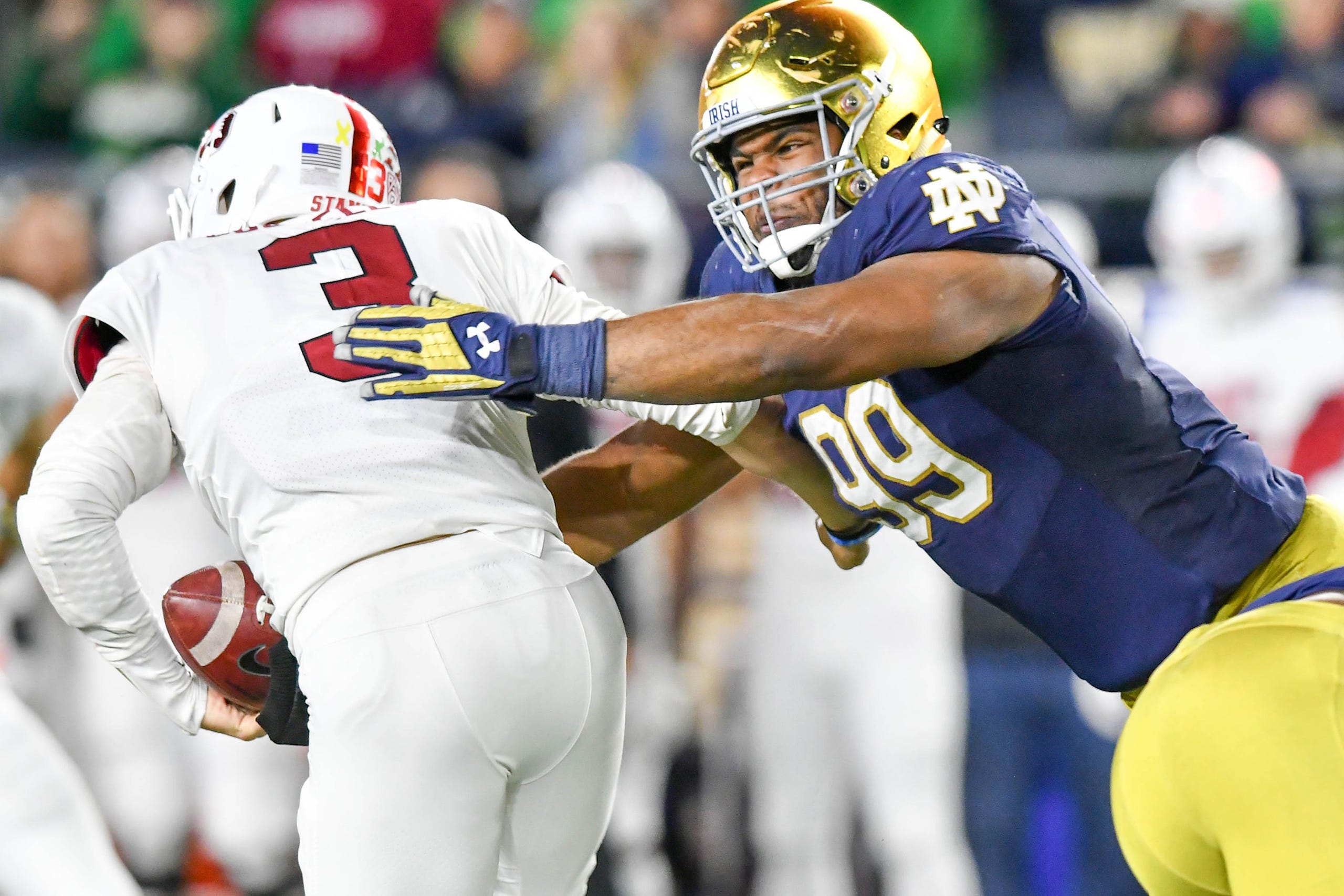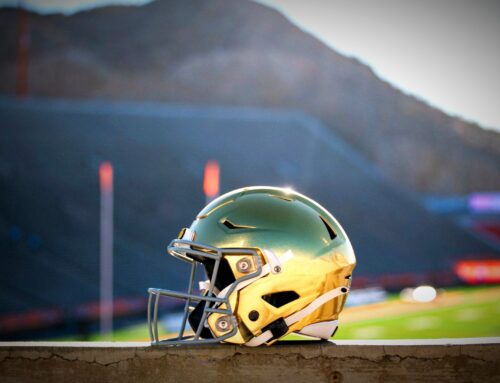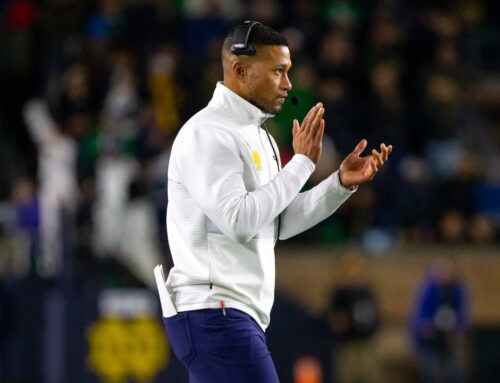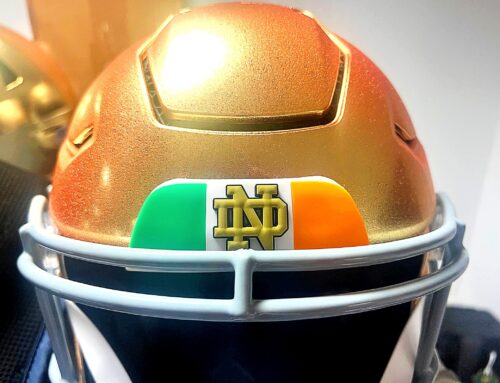Welcome to the first installment in a dog days deep dive series on Irish football recruiting rivalries. There are schools that steal away a contested commit and you read the news dispassionately, or perhaps furrow your brow in momentary confusion over the decision. And then there are a few key schools who make you go all Captain Kirk when they do it, because DAMMIT THEY DID IT AGAIN. We’re talking about those schools: Stanford, Michigan, USC, Oklahoma, Ohio State, and Washington.
We’re going to kick the series off in style by checking in on one of the most heated rivalries, that with the Stanford Cardinal. We touched on this a bit in a pregame post last year about Notre Dame’s Stanford problem (which I assume inspired the lads to the 38-17 rump-wrecking), but that was just a surface glance. This will be a deeper look at how things have gone.
Methodology
I’m going to include every commit who had offers from the other team, even if I know those offers weren’t really committable in some cases. This is because while I know that in some cases, I’m aware that neither I nor anyone else truly knows the status of all offers. Plus I have much more intimate knowledge of Notre Dame recruiting than opponents’ recruiting, of course, and it would be intellectually dishonest of me to say “they got recruit X because we didn’t push” and ignore the potential for that to happen in the other direction as well.
I broke the Kelly Epoch down into three distinct chunks to compare these rivalries: the 2011-14 classes, which we’ll call the Diaco Era, the 2015-17 classes, which we’ll call the BVG Era, and the 2018-20 classes, which we’ll call the Revival Era. Notre Dame’s on-field record in those three eras are, in order, 37-15, 22-16, and 22-4. Keep those in mind as you consume the other info here, as they’re obviously major factors in themselves. Note that while I’m using the DC’s names, we’re still looking at recruits on both sides of the ball in those eras. It’s just a convenient nomenclature.
At the micro level, be aware that you’re going to see Eddie Vanderdoes and Tee Shepard a lot in this series. I’ll talk about the picture without them too, but as this is mostly a look at recruiting battles and not eventual on-field performance it’s fair to count all signees. Regardless of what happened after, we did beat everyone on the trail for those two guys.
Finally, we’ll cap each review with a quick look at the 2018-2020 cycles. Those are the ones that coincide with a better on-field product and a more recruiting-focused coaching staff, which should give us more of a sense of what is possible when things are going well.
The Scoreboard
| Wins | Losses | |||
| Year | Off | Def | Off | Def |
| 2011 | 3 | 4 | 1 | 1 |
| 2012 | 4 | 1 | 4 | 3 |
| 2013 | 5 | 1 | 1 | 1 |
| 2014 | 3 | 0 | 3 | 3 |
| 2015 | 7 | 0 | 1 | 3 |
| 2016 | 1 | 2 | 0 | 2 |
| 2017 | 0 | 2 | 2 | 5 |
| 2018 | 1 | 2 | 1 | 3 |
| 2019 | 2 | 3 | 3 | 4 |
| 2020 | 3 | 0 | 2 | 0 |
| 29 | 15 | 18 | 25 | |
| 44 | 43 | |||
| 50.6% | ||||
Overall, the Irish are essentially in a dead heat with Stanford over the last decade. The offensive and defensive pictures are mirror images, and there have been some high profile wins and losses; in the end, though, it seems like it’s a statistical wash. “Seems like” is the key part of that. As we delve deeper, some very interesting numbers emerge.
Wins and Losses
| Win Percentage by Era | |||
| All | Off | Def | |
| 2011-14 | 55% | 63% | 43% |
| 2015-17 | 48% | 73% | 29% |
| 2018-20 | 46% | 50% | 42% |
Now, as noted above, wins and losses on the field play a huge part. Even so, it’s hard to look at that drop in defensive wins on the trail from the Diaco Era to the BVG Era and not connect it to, well, BVG. Bob Diaco hated recruiting and put a minimal amount of effort into it; somehow, Brian VanGorder was even less interested and thus put less effort into it. We’ll see this phenomenon [spoiler alert] almost across the board in this series. The offensive trend is interesting and doesn’t seem immediately explainable – why would it go up in the BVG Era and down in the Revival Era? Why is the Revival Era, with its 22-4 on-field record, the “worst” Irish offensive recruiting performance of this rivalry? One more step down into the data yields a potential reason.
Quality Control
| Avg. 247C Score – Offense | |||
| W | L | Diff | |
| 2011-14 | 0.9263 | 0.9569 | -0.0306 |
| 2015-17 | 0.9254 | 0.9455 | -0.0201 |
| 2018-20 | 0.9429 | 0.9218 | 0.0212 |
| Avg. 247C Score – Defense | |||
| W | L | Diff | |
| 2011-14 | 0.9132 | 0.9296 | -0.0165 |
| 2015-17 | 0.9092 | 0.9111 | -0.0019 |
| 2018-20 | 0.9201 | 0.9015 | 0.0186 |
And here we see that key additional context. Yes, Stanford is doing well if you look at the raw count, but when you look at the average quality of the recruits, another very clear trend emerges. The -0.0306 offensive differential during the Diaco Era is absolutely massive; for reference, 0.9500 is roughly a top 100 player and 0.9200 is roughly a top 200 player. The -0.0201 offensive differential in the BVG Era is, similarly, not great. The picture on the defensive side is not as stark, but it’s similar. They were pulling higher-rated guys than we were.
Then the rivalry pulled a 180 in the Revival Era. The flip to a +0.0212 offensive differential and +0.0186 defensive differential is remarkable. Stanford is a little bit different from the other competitors in this series in that we go head-to-head less with them when we’re doing better in the wider pool of “football first” kids. It’s not that surprising, then, that they’ve taken slightly more “wins” over the Revival Era while our win quality has gone up substantially. There’s no question that we have definitively beaten them on the recruiting trail in the last few cycles.
It’s also worth noting that the quality of Stanford’s wins on both sides of the ball declined steadily over the three eras. A trend that bears watching.
Highlights/Lowlights
As you might imagine, many of Stanford’s best wins came on the offensive line. They’ve pulled four five-star OL from the Irish since 2011 – Foster Sarell in 2017, and Kyle Murphy, Andrus Peat, and Josh Garnett in 2012. Other guys who stand out are:
- Five-star DL Solomon Thomas, 2014; Notre Dame had a real shot at him early, but alas, BVG
- Top 100 CB Alex Carter, 2012; never really showed much interest in Notre Dame despite being Tom Carter’s kid
- Four-star CB Paulson Adebo, 2017; one-time Notre Dame commit who is a likely All-American this year
- Four-star WR Osiris St. Brown, 2017; younger brother of Equanimeous and older brother of Amon-Ra whose interest was nil thanks to the 2016 on-field disaster
Now that I’ve given you a nice paper cut and poured lemon juice over it, let’s look at some of the more notable Irish wins:
- Five-star OLB Ishaq Williams, 2011
- Five-star QB Gunner Kiel, 2012
- Top 50 RB Chris Tyree, 2020
- Top 50 QB Brandon Wimbush, 2015
- Top 100 S Kyle Hamilton, 2019
- Top 100 OT Quenton Nelson, 2014
- Top 100 OT Tosh Baker, 2020
- Top 100 OG Zeke Corell, 2019
- Top 100 OLB Shayne Simon, 2018
They’ve gotten us a few times, but we’ve certainly gotten them too. One fun little note I uncovered during the research for this series: Tosh Baker is the only Irish commit/signee since at least 2011 to hold an offer from each of Stanford, Michigan, USC, Oklahoma, Ohio State, and Washington. It’s pretty labor intensive to research any further back than that, so, uh, I’m not going to do it, but I would guess it goes back much further than that as well. He might be pretty good.
Recent History
| 2018 | |||||
| Notre Dame | Stanford | ||||
| OLB | Shayne Simon | 0.9567 | WR | Michael Wilson | 0.9106 |
| WR | Braden Lenzy | 0.9174 | WDE | Andres Fox | 0.9073 |
| CB | DJ Brown | 0.8802 | SDE | Thomas Booker | 0.9032 |
| WDE | Tobe Umerah | 0.8806 | |||
| 2019 | |||||
| Notre Dame | Stanford | ||||
| S | Kyle Hamilton | 0.9700 | WR | Elijah Higgins | 0.9601 |
| OC | Zeke Correll | 0.9578 | RB | Austin Jones | 0.9471 |
| CB | KJ Wallace | 0.9017 | SDE | Joshua Pakola | 0.9214 |
| OLB | JD Bertrand | 0.8918 | CB | Salim Turner-Muhammad | 0.9086 |
| RB | Kyren Williams | 0.8918 | OLB | Tristan Sinclair | 0.9079 |
| OT | Walter Rouse | 0.8837 | |||
| WDE | Aeneas DiCosmo | 0.8817 | |||
| 2020 | |||||
| Notre Dame | Stanford | ||||
| RB | Chris Tyree | 0.9823 | WR | John Humphreys | 0.9443 |
| OT | Tosh Baker | 0.9671 | WR | Bryce Farrell | 0.8847 |
| OT | Michael Carmody | 0.9412 | |||
I would give the Irish a slight edge in 2018. Notre Dame didn’t pursue Booker or Umerah very aggressively, and likewise I don’t think Stanford chased Brown all that hard. Of the guys remaining, I would weight Simon and Lenzy a bit heavier than Wilson and Fox – I think either school would’ve been happy to take both kids that chose the other, but in the end I think Notre Dame landed the better prospects. [CORRECTION: As pointed out by nd09hls12 below, I got coverage of Booker’s recruitment mixed up with analysis of Booker. The Notre Dame staff very much wanted Booker, which clearly tilts 2018 to the Stanford win column.]
2019 is a much harder call. I’m confident that Notre Dame really wanted Jones, Pakola, Sinclair, Rouse, and DiCosmo. At the same time, it’s hard to worry too much about losing Rouse and DiCosmo given the quality of the OL and DE units in Notre Dame’s class, and I don’t think the Irish chased Turner-Muhammad much after some initial interest. The staff also clearly believes very strongly in Jack Kiser and Marist Liufau at OLB, and Sinclair was always a long shot given that he’s a Stanford legacy. In the other direction, I don’t think Stanford chased Williams or Bertrand that hard, but they would’ve killed to land Hamilton, Correll, and Wallace. I’m tempted to call this a push, although I wouldn’t argue if you wanted to nudge it over to Stanford’s side a hair.
2020 is, to this point, thunderously in Notre Dame’s favor. Humphreys is a Californian and a triple Stanford legacy – both parents and an older sister went there. So Notre Dame sort of went head-to-head, but there was no way Humphreys was going anywhere but Stanford once he got the offer. Farrell was not a key target for the Irish. Stanford was never a true competitor for Tyree but would definitely have taken him if they could have, as they would have taken Baker and Carmody.






This is a truly awesome idea for a series.
D2acco seemed to be a pretty good DC. I wonder if he would be better off in the NFL where recruiting isn’t part of the job.
BVG. He was a decent facial hair grower. Would have been better off in 70s adult films, far from a football field.
Excellent breakdown — I love this type of comparison! Not to add to your workload, but are there key advantages that a school like Stanford has over ND, when it comes to what would it make it more appealing to a recruit? Such as, slightly higher academic reputation, ability to drop courses at the last minute, northern Cal climate. I imagine there are also some advantages that ND has (e.g., lengthy football tradition, spirituality).
I think the big things that are always going to be in their favor are academic reputation (“slightly” is probably underselling it, well, slightly, but not worth splitting hairs) and location. Their campus is beautiful, the weather is better, and the Bay Area clobbers South Bend. I think the ability to drop classes late helps them keep kids eligible but I’d be stunned if it’s on the radar for any recruit.
As you note, Notre Dame has its own advantages too of course; our campus is beautiful too, just in a very different way, and while Stanford’s vibe centers on innovation, Notre Dame’s vibe centers on tradition. They’re just different, and some kids will feel more comfortable with one or the other. Spirituality can be a major mark for Notre Dame, but only of course if the kid values that.
The biggest factors by far are success on the field (overall and, somewhat less importantly, head-to-head) and recruiting ability of the staff. Everything else IMO is far behind those. If we’re 10-2/11-1 every year and Stanford is 8-4/7-5, those mild Januaries are going to matter a whole lot less to recruits. And vice versa.
Our location can help in some respects: some East Coast folks just aren’t willing to go all the way across the country. So we might get somebody who, all other things being equal, would have picked Stanford, but also wanted their parents to be able to go to most games and/or just be closer to home generally. Of course, the opposite could apply to California kids, but overall being close to the East Coast is better than the West Coast.
But, agreed that success on the field and the selling ability of the staff significantly outweigh all that.
To pick a nit: ND recruited Thomas Booker *very* aggressively and wanted him quite badly, IIRC. It was just that the recruitment was essentially over once Stanford offered. He would have been the only 4-star DE from that class. Thankfully, DE recruiting has picked up quite a bit since then.
I don’t think we recruited Fox very hard that year, though, if that’s who you meant.
Ah, you’re right on Booker – I mixed up some stuff with him. The staff did want him and pursued him heavily, and lost him once Stanford offered. I mixed that up with Jamie at ISD, who didn’t feel that it would be that big a loss in the end because he didn’t think Booker had that high a ceiling. He’s slated to start at DE this year, so I guess we’ll find out soon.
The staff did want Fox too as a WDE but never got anywhere with him. He’s a backup OLB as of now.
4 or 5 years ago I was obsessed with Stanford. It seemed like they were breathing us everywhere. On the field, visible, and recruiting.
Things are different now. As soon as we beat them at Stanford, and put that streak to an end, I don’t think I’ll be worrying to much about them anymore.